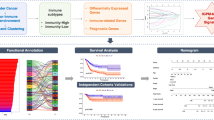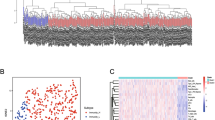Abstract
Immunotherapy based on immune checkpoint genes (ICGs) has recently made significant progress in the treatment of bladder cancer patients, but many patients still cannot benefit from it. In the present study, we aimed to perform a comprehensive analysis of ICGs in bladder cancer tissues with the aim of evaluating patient responsiveness to immunotherapy and prognosis. We scored ICGs in each BLCA patient from TCGA and GEO databases by using ssGSEA and selected genes that were significantly associated with ICGs scores by using the WCGNA algorithm. NMF clustering analysis was performed to identify different bladder cancer molecular subtypes based on the expression of ICGs-related genes. Based on the immune related genes differentially expressed among subgroups, we further constructed a novel stratified model containing nine genes by uni-COX regression, LASSO regression, SVM algorithm and multi-COX regression. The model and the nomogram constructed based on the model can accurately predict the prognosis of bladder cancer patients. Besides, the patients classified based on this model have large differences in sensitivity to immunotherapy and chemotherapy, which can provide a reference for individualized treatment of bladder cancer.
Similar content being viewed by others
Introduction
Bladder cancer (BLCA) is the most common malignancy of the urinary system, characterized by high morbidity and mortality. According to statistics, there were 573,000 new diagnosed cases and 213,000 deaths of bladder cancer worldwide in 2020, ranking tenth among all cancers1. According to the invasion depth of tumor, bladder cancer can be divided into non-muscle invasive bladder cancer (NMIBC) and muscle invasive bladder cancer (MIBC), of which NMIBC accounts for about 75%2. In recent years, despite the continuous improvement of surgical approaches, and the application of platinum-based neoadjuvant therapy and intravesical instillation of Bacillus Calmette Guerin (BCG) after operation have made significant progress in the treatment of bladder cancer, but the prognosis of BLCA patients is still far from satisfactory3. It has been reported that 40–80% of patients with NMIBC recur within 1 year after surgery, and 10–25% of these patients will progress to MIBC4. MIBC is prone to invade blood vessels, lymph nodes and develop distant metastases to form metastatic BLCA, and the five-year survival rates for muscle invasive MIBC and metastatic bladder cancer are estimated to be only 36–48% and 5–36%, respectively5. Therefore, it is urgent to develop effective and reliable prognostic and treatment strategies to improve the quality of life and long-term survival of BLCA patients.
With the development of gene sequencing technology, therapies for BLCA have been developed at the cellular and molecular levels. Studies have shown that BLCA has a relatively high total mutation spectrum compared to other types of tumors, and the number of neoantigens produced by it may also be higher. Therefore, administering immunotherapy to BLCA patients may be a potentially effective therapeutic measureFull size image
CTSE inhibits the progression from NMBLC to MBLC
To clarify the relationship between CTSE gene and BLCA, the CTSE overexpression was constructed in two human bladder transitional cell carcinoma cells lines T24 and J82 by transfecting with Ad-CTSE adenovirus (Fig. 12A,B), and the expression level of CTSE in the transfected group increased significantly after the successful construction (Fig. 12C,D). The CCK-8 results showed that the cells activity of the CTSE over-expression in T24 cells and J82 cells were significantly lower than that of the control group (Fig. 12E,F). At the same time, the colony formation assay showed that the colony formation of the CTSE over-expression in T24 cells and J82 cells were significantly inhibited compared with the control group (Fig. 12G). These results all suggest that CTSE can inhibit the progression of tumor cells.
CTSE over expression inhibits the proliferation of T24cells and J82cells. (A) Transfection of Ad-CTSE adenovirus in T24 cells. (B) Transfection of Ad-CTSE adenovirus in J82 cells. (C) The relative expression level of CTSE were determined using qPCR in T24 cells. (D) The relative expression level of CTSE were determined using qPCR in J82 cells. (E) The results of CCK-8 assay in T24 cells. (F) The results of CCK-8 assay in and in J82 cells. (G) The colony formation in T24 cells and in J82 cells.





